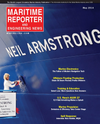
Page 31: of Maritime Reporter Magazine (May 2014)
Marine Electronics Edition
Read this page in Pdf, Flash or Html5 edition of May 2014 Maritime Reporter Magazine
www.marinelink.com 31 earning, and then converge afterward at a central location for a shorter and more effective face-to-face experience.
These are some of the quick facts.
Let’s look at the hard evidence now.
The Evidence
Arguably the best evidence of eLearn- ing effectiveness is a report published in 2010 by the U.S. Department of Educa- tion (U.S. DOE). The report is entitled “Evaluation of Evidence-Based Practic- es in Online Learning, A Meta-Analysis and Review of Online Learning Stud- ies”. The strength of this report comes from the fact that it is a meta-analysis. A meta-analysis looks at a large number of independent studies and draws a conclu- sion based on the strength of this large collection. This is powerful because the biases or fl aws of individual studies are quickly fi ltered out of the collective re- sponse.
In the case of the U.S. DOE study, the meta-analysis looked at roughly 1,000 research studies, and then fi ltered them down to 45 which met rigorous design standards. From these studies the analy- sis came to several conclusions. Let’s look at some of the most notable quotes from this study:
Conclusion Number 1
Online Learning Outperforms
Face-to-Face Learning:
U.S. DOE Quote: “Students in online conditions performed modestly better, on average, than those learning the same material through traditional face-to- face instruction. Learning outcomes for students who engaged in online learn- ing exceeded those of students receiving face-to-face instruction.”
The difference in effectiveness mea- sured between online and face-to-face instruction was quite small, but it ex- ists with the win going to online learn- ing. From this we can say unequivocally that online learning most certainly does not produce inferior outcomes when compared to face-to-face instruction, as many incorrectly believe. In fairness, however, until I performed my own studies on eLearning effectiveness as a university researcher in the 1990s, I also assumed that eLearning would be infe- rior. I was wrong.
Conclusion Number 2
Blended Learning is Best:
U.S. DOE Quote: “Instruction com- bining online and face-to-face elements had a larger advantage relative to purely face-to-face instruction than did purely online instruction.“
The conclusion above indicates that when you use a combination of on-line and face-to-face training (referred to as “blended learning”), the learning out- comes are better than for either face- to-face or eLearning alone. This makes intuitive sense because each mode of learning has strengths the other one can- not offer. The implications are clear.
If your goal is to provide the very best training possible, you should use a com- bined approach involving both face-to- face training and online learning.
Conclusion Number 3
Interaction with Peers and/or In- structors Improves Learning Out- comes:
U.S. DOE Quote: “Effect sizes [i.e. the improvement in learning outcomes] were larger for studies in which the on- line instruction was collaborative or instructor-directed than in those studies where online learners worked indepen- dently.”
This is a very important conclusion which cannot be stressed enough. One of the major advantages of online learn- ing is its ability to connect people to one another, allowing them to learn from one another in a way that face-to-face training can’t. While it is indeed pos- sible and effective for trainees to learn online independently, the best outcomes are achieved when we use technology to connect people to further facilitate the learning process.
Conclusion Number 4: eLearning Works, Regardless of the Subject Matter:
U.S. DOE Quote: “The effectiveness of online learning approaches appears quite broad across different content and learner types.” eLearning has been around long enough and studied long enough that we can safely conclude that it is effective for all kinds of knowledge acquisition. There is nothing about maritime knowledge or maritime learners that makes the fi eld immune to the benefi ts of eLearning.
That is not to say that there are no hur- dles to overcome in maritime eLearning - there are. For example, the availability of internet on-board, and the sophistica- tion of vessel-based training both have slowed the adoption of eLearning in the industry. However, those obstacles are being (and have been) largely overcome by maritime-specifi c learning manage- ment systems (LMSs) and the industry is following suit by adopting eLearn- ing methods. This study makes it clear that the benefi ts of eLearning are not domain-specifi c. eLearning works. It has strengths which create an opportunity to do bet- ter than we do now. It is not a replace- ment for face to face or hands-on train- ing, that is the wrong discussion to be having because we already know the answer. The real discussion is about how we apply the strengths and advantages that eLearning brings to an industry that is in desperate need of better (not more) training, more uniform training, and an elevated discussion on what we can do to achieve these.
The Author
Pek Murray Goldberg is CEO of Marine
Learning Systems (www.MarineLS.com).
An eLearning researcher and developer, his software has been used by 14 million people worldwide. 147 Columbia Turnpike, Suite 203
Florham Park, NJ 07932 USA
Sign Up Now for Our 2014 Essential
Maritime Management Training Programs
Contract Management for Ship
Construction, Repair & Design
Seattle, WA May 20-22, 2014
Halifax, NS Sept. 9-11, 2014
The Port Engineer’s and
Owner’s Representative Course
New Orleans, LA June 17-19, 2014
Tampa, FL Oct. 28-30, 2014
In-house programs are also available. They are particularly cost effective for groups of 10 to 25. Please call to discuss.
Register online or contact us at: [email protected] 1-800-732-3476 (US/CAN)
For more information: www.shipcontractmanagement.com
For more information: www.shipportengineer.com
Consulting GroupConsulting Group
FISHER
MARITIME
FISHER
MARITIME
Consulting Naval Arcr hitects and
Marine Engineers, Project Manar ga ers
MR #5 (26-31).indd 31 4/30/2014 3:19:58 PM

 30
30

 32
32
